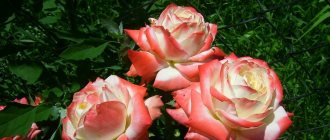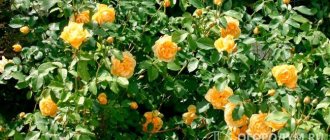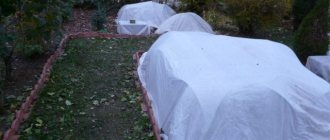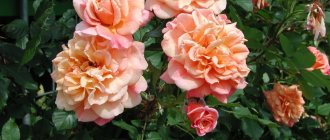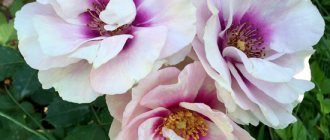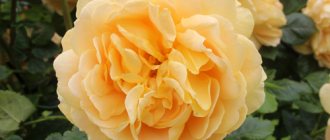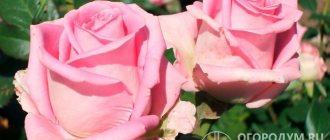History of selection
Translated from English, “Blue Moon” means “Blue Moon”. The plant received this name for the unusual cold lilac or blue tint of the petals of the buds. The Blue Moon rose variety was bred in the second half of the twentieth century (1964) by Tantau plant breeders. It was a bush hybrid tea rose, which quickly gained popularity among gardeners.
Ten years later, scientists discovered a random bud mutation that gave the flowering plant the property of climbing. Biologists call this phenomenon “climbing,” which translated from English means “to rise,” “to climb.” An accidental discovery gave rise to the creation of a new species - the Blue Moon climbing rose. Its originators were the Australian Julie Jackson and the American Fred A. Mungia.
Blue Moon has been awarded two gold awards at international flower shows. This flower received a test certificate at the Bageigne competition, which was held in Paris.
The climbing variety Blue Moon was developed in the second half of the last century
Conditions comfortable for the Blue River
It is quite easy to choose comfortable lighting for Blue River. This is a light-loving rose that feels better in sunny locations. But even in partial shade it will bloom no less colorfully (however, there it becomes more vulnerable to diseases and pests, and it is still better to provide good lighting for the Blue River).
Rose "Blue River" Roland zh
Try to protect this rose from cold winds, because it is not the most resistant and hardy plant that may feel uncomfortable in windy areas. But this requirement applies only to cold winds, and not to drafts. A prerequisite for success in growing Blue River is proper ventilation of the foliage and free, active air circulation. This rose does not respond well to wetness and precipitation. Wet leaves should dry out very quickly, and for this the rose itself must be placed in well-ventilated, warm areas.
Pay attention to the choice of soil. It should be rich in organic matter and nutrients
It is imperative to ensure “Blue River” and water permeability and a loose texture. Even on ideal soil, a drainage layer is still laid.
Description of climbing rose Blue Moon and characteristics
The climbing rose Blue Moon is a vigorous, spreading plant, the height of the stems can reach 3 m, and in regions with a warm climate, 4 m. The width of the bush is 70-80 cm. The dense and strong shoots of the Blue Moon have practically no thorns. The color of the stems is dark green.
The blue climbing rose Blue Moon is characterized by the presence of complex leaves, each of which consists of several simple, rounded, elongated and slightly bent outward leaf blades. The leaves are matte, dark green. The edge of the leaf blade is serrated. The foliage of the stems is intense.
Rose Blue Moon is a repeat-blooming plant, that is, flowering occurs twice a season with a short break. The flowering period of Blue Moon is quite long - the first buds appear in early summer, and the last in mid-autumn. With proper care, the interval between the first and second flowering can be practically unnoticeable. As a result, it seems that the plant blooms continuously.
Unopened Blue Moon buds are usually purple in color. When they open, they turn into large flowers, about 12 cm in diameter, with blue, purple or light lilac buds. Each flower basket consists of 25-30 petals, the shade of which depends on the location of the plant: in the shade they are lilac, and in the sun they are rich blue. The buds can be single or collected in small inflorescences of 3-5 pieces. During the flowering process, the shape of the flower basket changes. At first it is a conical bud, and then goblet-shaped.
The flowers have a pleasant, subtle aroma of rose oil with subtle citrus notes. It is noteworthy that the smell emitted by the flowers of the rose bush persists throughout the entire flowering period of Blue Moon.
After flowering ends, false fruits of a rounded-elongated shape with small seeds are formed on the receptacle. The seed material is suitable for propagating the Blue Moon rose, but it is used extremely rarely for this purpose.
Blue Moon is a heat-loving plant, so a drop in temperature below -20 °C can be disastrous for it. In the Russian Federation, the climbing rose Blue Moon feels good in the southern regions, but flower growers in central Russia who want to have this whimsical beauty in their garden will have to work hard.
Attention! Blue Moon is also grown in regions with cool climates. The main thing is to choose a sunny place for it and cover it well for the winter.
For a climbing rose you will have to build a support
Differences between Blue Moon and Blue Girl roses
In terms of external features, the climbing rose Blue Moon, as seen in the photo, is somewhat similar to Blue Girl.
Blue Girl and Blue Moon are highly decorative
Both plants are repeat bloomers and have a long flowering period. However, there are significant differences between them.
| Blue Moon | Blue Girl | |
| Plant type | Rose hybrid tea climbing | Hybrid tea rose bush |
| Stems | Strong curly, 350-400 cm high | Powerful, erect, 60-70 cm high |
| Leaves | Matte dark green | Semi-gloss dark green |
| Flowers | Goblet-shaped, located singly or in groups of 3-5 pieces. The flower basket is goblet-shaped, consists of 20-25 petals of a blue or lilac hue | More luxuriant than that of the Blue Moon, the double flowers are arranged singly. A terry flower basket is formed by about 40 lavender petals |
How to plant correctly?
Climbing rose “sympathy”: description of the variety, features of planting and care
To grow a bonsai from wisteria, it can be planted in several ways. Let's describe each of them.
Horizontal layering
- They choose a long shoot from last year and dig a trench under it.
- Fill the hole with nutritious soil and moisten it abundantly.
- A shoot with cut buds is placed in the trench, which is then secured to the ground - metal pins are suitable for this.
- After this, they are covered with soil, leaving only the top. Root shoots will grow from leaf buds.
By cuttings
- In the autumn, the mother shoot is cut off.
- Then it is cut into cuttings so that a bud remains on each of them.
- The cuttings are planted in small containers and placed in a dark place until spring.
- At the beginning of spring, the sprouted cuttings are planted in a permanent place.
Seeds
- The seeds are placed in a gauze cloth and dipped in water to soak until they hatch.
- After this, the seeds are planted in moist soil.
- A high-quality substrate consists of three components: three parts of leaf soil, 1 part of leaf soil and 1 part of river sand.
- Be sure to take care of the drainage layer - brick chips or expanded clay are suitable.
- The seeds are placed in the substrate to a depth of 1 cm.
- Cover the container with film or glass and move it to a dark place at a temperature of 20-24 degrees.
To grow a tree from wisteria, you need to follow the following recommendations:
- Install a support near the future tree, the thickness of which should be at least 5 cm, and the height should be approximately 2-2.5 meters.
- At the top of the support, build a frame that looks like an umbrella.
- The first year, wisteria grows freely. Prune in spring to stimulate side shoots.
- Twist all subsequent shoots in one direction and distribute them over the umbrella.
- Every year, cut the shoots by 2 buds, giving the tree a spherical shape.
We invite you to watch a video on how to grow wisteria from seeds:
Advantages and disadvantages of the variety
Rose Blue Moon has many advantages. However, it also has disadvantages.
One of the advantages of the Blue Moon rose is its unusual color.
Pros:
- highly decorative;
- pleasant aroma;
- almost complete absence of thorns;
- re-blooming.
Minuses:
- poor frost resistance, which necessitates serious protection from winter cold;
- weak immunity to diseases;
- the need to construct supporting supports.
Reproduction methods
There are three ways to propagate climbing roses:
- By cuttings. Cut cuttings of approximately 12 cm, treat the cuts with a preparation for rapid rooting (Kornevin) and plant them in moist soil under a glass jar.
- By layering. After flowering ends, one of the stems is buried. When the cuttings take root, they are transplanted to a new place.
- Dividing the bush. Dig up a bush and use a sharp knife to divide the root system into several parts. The resulting divisions are transplanted to a new location.
Attention! Each cutting should have three buds, and each cutting should have at least two viable shoots.
Greenhouse conditions are required for rooting cuttings
Landing
To plant a perennial liana, you will need 2 seedlings, the root system of which must be of a closed type.
This factor affects the adaptation of the plant, making it less painful. Wisteria can be cultivated in any soil. It is best to plant in a place with slightly alkaline soil. It is also recommended to add humus to the soil and drain it well. Strongly acidic peat soil is not suitable for growing vines. Before planting wisteria, dig a hole 25 centimeters deep and fill it with organic fertilizer. Humus is best. You can prepare a mixture of thawed leaves, river sand and clay soil. The plant is planted using the transshipment method, without deepening the root collar area.
The seating area should be well lit. Wisteria flowers need sunlight for normal development. The plant must also be well protected during the cold season. Therefore, having a wall close to the seat will help protect against drafts and wind. Due to the characteristics of wisteria, it is recommended to plant it in a calm and warm place. The shoots of the plant weave strongly, for this reason it needs supports that are installed near the vines.
Growing and care
For a rose, a place in the open sun or in lace shade is suitable. The optimal time for planting is considered to be the second half of May.
Landing
The planting material is kept in water for several hours. This allows the roots to expand and also absorb moisture.
The landing algorithm is as follows:
- the selected area is dug up, a hole of the required size is made and drainage is laid;
- the seedling is placed in the middle of the hole, the roots are straightened;
- cover the shoot with soil, deepening the neck by 2-3 cm;
- the soil is compacted, watered and covered with mulch.
Advice! Excess moisture can cause rotting of the root system, so it is better to plant the rose in a place where water will not accumulate in the spring, as well as during the rainy season.
Care
The Blue Moon rose variety cannot be called an unpretentious plant. In order for it to grow normally and delight with lush flowers, it needs to be provided with proper care:
- regular but not excessive watering, the frequency of which depends on weather conditions;
- loosening, which should be carried out after each watering, and removal of weeds;
- fertilizing, which is done 5-6 times during the entire growing season of roses using special complex fertilizers for roses;
- pruning - in the first year, damaged areas of vines and weak shoots are removed, in the second and subsequent years, side shoots on the main lashes are cut by ½, and old stems are also removed.
Attention! If you leave old shoots that do not throw out buds, the decorative value of the Blue Moon rose will decrease over time.
Rose needs moderate watering
Protection from diseases
Although the Blue Moon rose is resistant to disease, infection is possible if it is not cared for properly, as well as in damp and cold weather. Therefore, preventive treatment of the bush should be carried out regularly. The most common diseases include:
- Powdery mildew. A white coating appears on the leaves, the foliage loses its healthy appearance and falls off. The bush is treated with copper sulfate or special products Topaz or Forecast.
- Gray rot. The foliage is covered with a gray-yellow coating. In case of illness, Fundazol or Euparen is used for treatment. The bush needs to be treated 2 times with a break of 14 days.
- Rust. Foliage and shoots are covered with orange stains. Infected parts of the plant are cut off and burned. The bush is treated with Fundazol, Tilt or Fitosporin.
Rose Blue Moon can be attacked by insect pests such as spider mites, aphids, leaf rollers, sawflies, and thrips. To combat them, special insecticides are used.
Application in landscape design
The high decorative value of the Blue Moon makes it possible to use it in landscape design to decorate fences, walls, open terraces and gazebos. Arches, pergolas and columns entwined with blue and lilac roses can become one of the main attractions of any site. A climbing rose fixed on supports stands out against the green lawn.
Good neighbors for Blue Moon will be clematis and conifers (cypress, thuja, blue spruce, juniper). In front of the bush you can plant low-growing flowering plants - asters, lavender, sage, bluebells.
A climbing rose is planted at the entrance to the house
Planting hybrid tea roses
Landing should be done correctly. After all, the future life of the plant depends on this.
- Should be planted in spring. By this time the soil will warm up. For 3 liters of water per rose seedling. You should get vermicompost.
- Dig a hole up to 60 cm deep.
- Pour humus into the ground and mix. Fill in half of the hole.
- The seedling itself can be purchased in March. You need to keep it in a cool place. This could be a basement or a refrigerator. Can be planted in a pot with soil.
- Cut off the roots.
- Soak the plant in water. No more than half an hour.
Planting process:
- The land must be fertilized in advance.
- Lower the plant into the hole.
- If the soil is dry, then you need to moisten it. You will need up to 2 liters.
- Cover with soil.
- Water again.
- If the flower is sick. It should be immediately treated with special medications for diseases. Otherwise, it may infect other plants.
